
![]()

|
|
|
|
|
|
Wehrmacht
(Das Heer)
Page 31
|
|
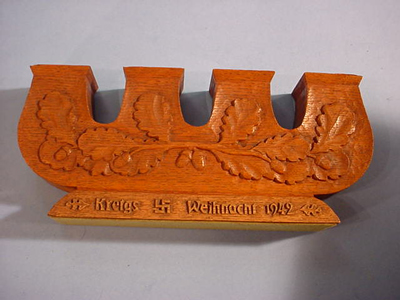 |
Wooden Christmas Candle Holder (Item WEHR 31-1) |
|
DESCRIPTION: This is beautiful, this is meaningful. This is a wooden candlestick holder carved from oak and it was used at the front lines of a German army position on the Western Front. The carving is exquisite with a garland of oak leaves and acorns carved on both sides. Also, there are beautifully carved words on the front: “Kriegs Weihnacht 1942.” The German soldier for the greatest part was a Christian Protestant or Catholic and that is precisely why we are just as saddened by the deaths of these “Christian Soldiers.” As we are about the boys from the Allied side who gave their lives for what? You can believe the stories that abound about what American and Britain were fighting for OR you can read Patrick Buchanan’s book The Unnecessary War. Again, don’t get me started, my perspectives about WWI and WWII are far from the orthodox view as promoted by “The Ministry of Truth” as Orwell would put it “Hail Big Brother.” I’m sorry but my input as a revisionist historian cannot be contained as I handle these meaningful relics of the turbulent times and the misinformation that we have been so “professionally spoon fed” Back to the candlestick...the measurements are 12" x 5 ¼" and 2 ¼" inches thick. The translation of the words “War Christmas 1942" with oak leaves to each side of the saying and a swastika in the middle. This wonderful piece of trench art or folk art stands today as a reminder that even in a horrible brother-against- brother fratricidal war, the spirit of Christmas, as the birthday of the “Prince of Peace,” was celebrated even by those terrible Germans that we read so much about in the yellow rag journals or on the TV and movies. In any case, this is one beautiful art piece. And should be preserved for posterity. PRICE: SOLD |
|
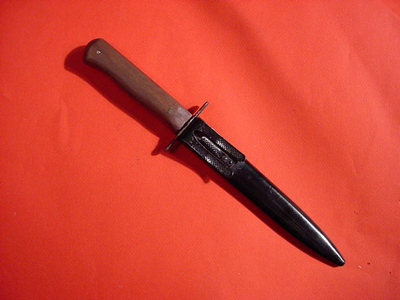 |
 |
|||
German Combat Soldier's Boot Knife (Item WEHR 31-3 & WAF 11-10) |
|||
DESCRIPTION: Originally designed to clip over the edge at boot top. This was a knife designed to lightly clip onto any part of the uniform (very handy) This particular style was used extensively by the Waffen SS but also the Army and some pilots of the Luftwaffe favored them as well.The blade has some old stains???/ But the entire knife is in very good condition and the clip is still very tight. This one could probably tell some tales. regarding the stains ??? PRICE: SOLD |
|||
 |
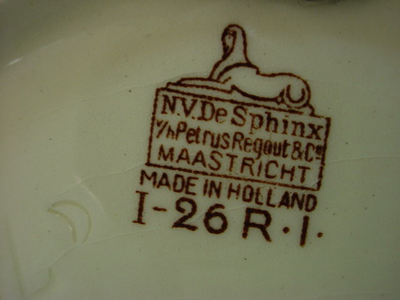 |
Decorative Plate Commemorating the Military Mobilization of the Netherlands 1939 (Item WEHR 31-4) |
|
DESCRIPTION: The plate doesn’t fit exactly into any of our categories, but it was so artistically beautiful, we just had to include it. After all, it is part of WWII history. It refers to the mobilization of the border troops of the area, Brabant-Limburg. It didn’t do them much good because the Wehrmacht easily rolled over them when the invasion of the lowlands began. But it was a pretty dish anyway. It has an interesting label under the glaze on the back -- a company in Maastricht used the sphinx as their logo. Because the plate is more for export, it says, in English – “Made in Holland.” Nice. PRICE: $58.00 (We have two!) |
|
 |
 |
Army Flack Badge (Heeres-Flakabzeichen) (Item WEHR 31-5) |
| DESCRIPTION: Authorization for the award of the army flack badge, following its institution on July 18 1941 by the OKH, came from Commanders holding the rank of General der artillerie and above. It was bestowed in a single class, dull grey, on an accumulated point basis with 16 points being the requisite, or could be awarded without reference to the number of points for an act of bravery or merit in the conduct of performing the anti-air craft mission.
Any anti-aircraft battery credited with downing an enemy aircraft without support of other batteries was awarded four points but if other batteries assisted in the downing of the aircraft, only two points were awarded. Unlike the Luftwaffe flack badge, points could not be awarded for targets destroyed on the ground. The badge that we offer is in fine condition & is unmarked as to maker. PRICE: SOLD |
 |
Wonderful Russian Peasant Box Hand Made and Presented to a German Wehrmacht Officer (Item WEHR 31-6 & RUSO 5-11) |
||
DESCRIPTION: This is typical of the art of the Ukraine and is absolutely gorgeous. It was presented to an officer who commanded a company of Cossacks who were fervently anti-Bolshevik and served on the German side in World War Two from 1941 to 1945. This information came from the German family survivors to our agent and picker. The box is of wood and the flowers and symbols are hand set into the surface. A very tedious task and it shows much talent of the maker. Each portion of the decoration had to be individually cut out and then fitted with the inlay of various types of wood in many sections of placement. The design is very typical of the Ukraine with the sunflowers and star designs. The central theme is the “Deutsche Adler” or German National eagle design. Also professionally inlaid in wood above this eagle is a symbol of a barrel type design with five spears emitting from each side. This would take some research but it looks somewhat like the Cossack insignia worn on the collar tabs of their uniforms -- this theory is at best vague but it is a possibility. The box measures 6" x 8" across and about 3 inches deep. The condition is great! And, it is very important historically and is just a beautiful artistic accomplishment. It is Russian peasant art from a people subjugated under the Bolshevic heel but still proud and noble. This is a token of the keen comradeship that developed between the German Wehrmacht soldiers of Liberation and Cossack brotherhood of the steppes. PRICE: $889.00 |
||
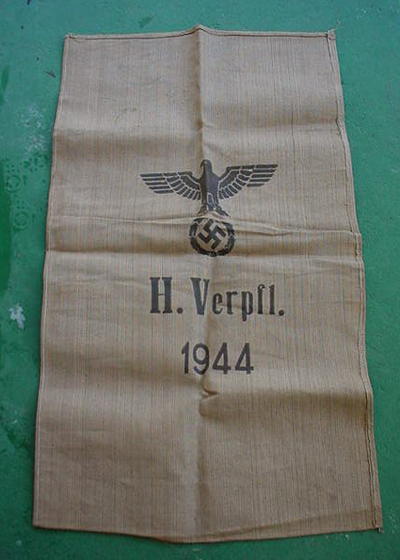 |
 |
Grain Sack for the German Army (Item WEHR 31-7) |
| DESCRIPTION: This is one of the burlap sacks as used to carry such supplies as potatoes, beans, bread, etc.; they were used throughout the entire war. Under the eagle and swastika and above the date of 1949 you can see the initials H.VpFL “Heeres-Verpflegung” which stands for Army Supply Service. They might not be the prettiest German war relic but to the soldiers of the Wehrmacht, they were ultra important. “ An Army travels on its stomach.” PRICE: SOLD |
 |
 |
Cossack Sword (Shashqua) For the Cossack Brotherhood Serving in the German Wehrmacht (Item WEHR 31-8 & RUSO 5-12) |
DESCRIPTION: This is the classic Cossack sword of the Steppes as used for centuries; however, this one has the Nazi eagle and swastika molded in the brass hilt. We remember when a large grouping of these were located in Europe and were purchased by a British dealer. The story was that the swords were produced by a firm that was located somewhere in the Caucasus and the small factory produced the swords for the Communist Cossacks with Hammer and Sickle but when the small staff thought that Germany and its Allies would win the Crusade against Bolshevism, they changed over and produced these swords with the National Socialist eagle to be sold to the officers of the Cossack legions that now were attached to the German Wehrmacht such as the divisions of Don Cossacks, tThe Brotherhood under the command of the brave and noble officer Helmuth Von Pannwitz. The Germans who were well aware of the Cossacks fighting ability and supreme valor and thanks to the efforts of Pannwitz a true Cossack army with all of its traditions became a Cossack Cavalry Corp. They were particularly effective in Yugoslavia where they fought against the filthy murderous partisans of the bloody demon Tito. It is believed that these swords were produced late in the war and the purpose was to make them an issue weapon to these fighters who had been forced from their lands by the advance of the Red Army, but hoped in their service to the German army to be given a new territory in Byelorussia when the Reds were finally defeated. In the meantime the members of the Crusade were settled nearly at the end of the war in an operational area for the Cossack Cavalry Corps in northern Italy. This may have been where the swords were to be sent. But as dark Fate would have it, the Reds and their willing Allies, the US and Britain, triumphed against Europe and the horrible Fate of these brave men, women, and children ensued and they were turned over by the same ‘Allies’ to the Soviet authorities. Almost 50,000 of these poor souls were turned over, men, women, and children, who for the most part were horribly executed, while others were sent to Gulags or deported for force labor. No more noble, dedicated and wonderful people ever existed *(author's opinion). The U.S. and England should live in eternal shame for bringing about “Operation Keelhaul.” Read about it on Google. The sword is 100% original. It is crude to some extent due to the shortage of certain materials necessary to the production at that late stage of the conflict but certainly it was produced to create an esprit de corps in the warrior ranks but also to be effective in usage. No scabbards were found. The theory was to why no scabbards on any of these swords is this -- the swords were shipped to the Italian Cossack redoubt in cartons but the scabbards were to follow in another separate shipment but due to the fortunes of war were never shipped. The shop very probably was geography right in the way of the changing tides of action on the Eastern Front. Lets hope that if the Mongols took possession of the shop that they did not find one of these swords because if they did they would have been in absolute ecstasy while roasting alive the owner his wife, children and any employees. The sword is a large: 38 inches long, the grip is 5 ½ inches long, the grip is of wood. the blade is not marked. It shows much old rust -- we know they were stored for many years in a barn, before being discovered they were exposed to the elements although packed in hay in loosely bound crates. But unlike the Cossacks who would have proudly carried them, they survived! Someday they will reach their full value potential. But for now this is a bargain at... PRICE: SOLD |
|
Small War Flag (Reichskriegsfahne) (Item WEHR 31-9) |
DESCRIPTION: Here is a great little military flag of the Wehrmacht. So often seen on German war ships of the Kriegsmarine but actually was the flag used by all branches including the army. This is an ideal size that collectors are continually seeking. The German measurements stamped on the edging are 60 x 90 mm and that is 31 x 24 inches. It has the full staff rope intact and has the word Reichskreigsfahne on the bunting edge. Absolutely perfect condition. This great looking flag of this size was usually for the “Schnellboot” or PT boat type vessel. Looking for the perfect den decoration or front door posting? Here is the finest! Just as nice as they ever come. PRICE: Consignment $650.00 |
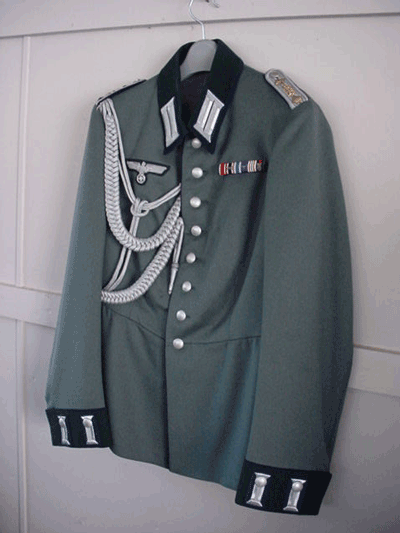 |
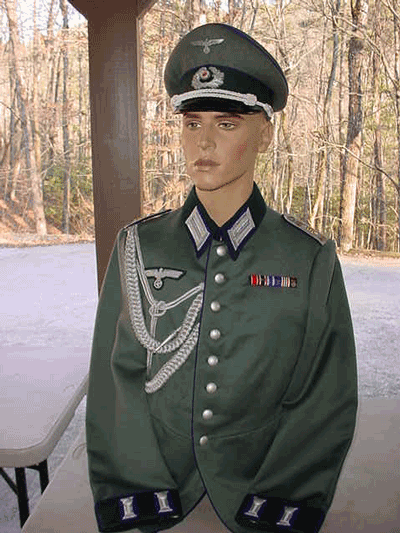 |
German Army Medical Officers Tunic (Item WEHR 31-11) |
DESCRIPTION: This beautiful tunic belonged to a Hauptmann-Captain (Sanitatsunteroffizier). The auguette suggests that he was also a medical assistant to what probably was a surgeon. Everything on the tunic suggested that it was tailor made -- all the boullion crisp and untattered. All insignia including the shoulder boards and breast eagle and collar tabs are sharp and neat. The Caduseus symbol and pips are gold colored. It has a battle ribbon bar with four medals that show his military history. He won the 2nd Class Iron Cross, theWar Service Cross, the Nazi Party Long Service Medal, the Army Long Service Medal, the Memel Land Medal and the Sudatenland Medal. This tunic is the early dress uniform “Wafffenrock” and this has to be the neatest yet most beautiful uniform in the world of militaria. So, here it is -- right out of the past, and 100% original. This was one sharp looking Doctor when attired in beautiful tunic! We also have a Medical officers cap with the blue piping (shown) but while the tunic is in exemplary condition the cap is with moth damage mostly on the top the cap has that wonderful jaunty look with the high lift to it that you all like to see in these caps. It would be great featured with the tunic as you can see in our pictures.
PRICE: SOLD |
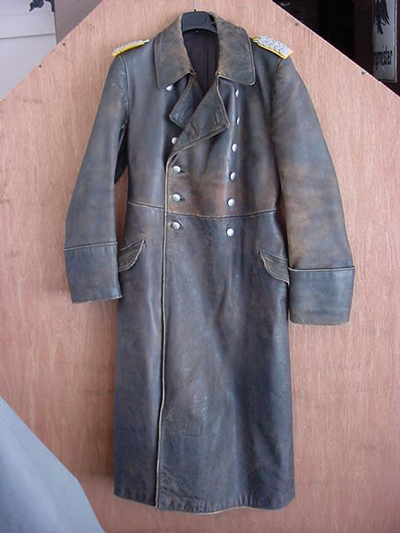 |
 |
A Leather Greatcoat for German Army Officer (Item WEHR 31-12) |
DESCRIPTION: This is what 75% of all WWII German collectors look for...a genuine German officer's grey leather greatcoat. This is the ‘real McCoy’ German officers of higher rank could wear store bought leather coats that approximate this coat if it would be their choice, but this was the only official Wehrmacht model made by the firm of Max Schleusner of Dresden. You can see his label in the pictures attached. Note that he was a 'Special' leather workshop for Wehrmacht and Sport. This coat is beautiful in form and design but it is very worn. Some of the inner sleeves are worn to a frazzle and pocket edges are frayed rather badly. However, it will still look sharp and jaunty on a manikin or on you perhaps. It was bought in one of our German field trips from the family of the man who wore it through many campaigns in the West and in Russia. After the war he wore it (usually sans the shoulder boards) right up to the early 90’s until he passed away. He was a Major in the Heers Signal troops and was right up there in all the major action. He had an extra set of shoulder boards stashed away in his wife’s keeping during the war. This was lucky because the ones he wore on the coat were taken from him by some GI when he surrendered. From time to time he openly wore the boards all around Munich after the war and was oftimes saluted by soldiers who served their country, and he was spat upon by cowards and lowlifes. His wife told us that a bunch of leftist goons who were really “the bottom of the barrel” tried to provoke him once near the Munich Hofbrau Haus. They held combs under their noses and gave Nazi salutes done in obvious hostile jest. Then one of them leaned over and ‘mooned him.’At that moment the old man quickly strode forward and shoved his foot ‘resoundingly’ practically up the buffoons ‘arshe’. The other three were getting ready to come to the aid of the red baboon who was howling in pain when some of our hero’s friends both old and young came out of the Hoffbrauhaus and ran them off with dire threats about “life and limb.” This old Major was the “Heldenmann” (hero) of the hour and the beer flowed that evening. So dear collector, here is the Coat of Champions. Note: pictures of some known and unknown Soldaten in our picture section wearing these Max Schleusner greatcoats. Yes, this “mantel” is a bit raggedy but authentic and no part of the traditional German uniform said it all like these handsome coats! PRICE: SOLD |
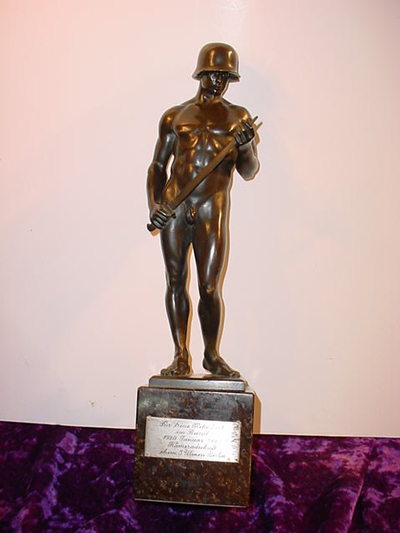 |
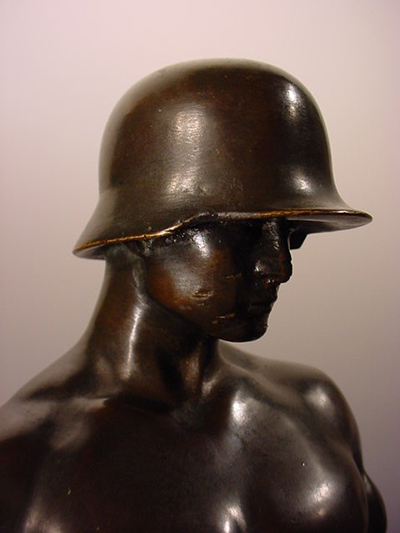 |
Bronze Soldier of the Reich (Item WEHR 31-14, WWI 12-2, ART 16-10, KSTATUE 5-6 ) |
DESCRIPTION: This marvelous statue measuring 13 ½ inches high with a base 4 ½ inches square (length and depth) personifies the strength and determination of the “Deutscher Soldat” from the time of the battle of the Teutoberg Forest up through the pages of history and into the 2nd World War. The slogan that might go with this wonderful sculpture could be “Die Ganze Welt Gegen Uns”! The whole world against us! Yes, Germany in the embodiment of the Heilege Vaterland was always to protect Europe against the constant incursions from the east against the Magyars, Huns ,Goths, and Visagoths and even the moribund Roman Empire. The land of Germania and its Teutonic Volk took on all comers. It was no different in the 2nd World War when Germany with a few allies stood against the Maelstrom in what was a German led crusade to destroy the beast of Bolshevism before all of Europe was disseminated by what President Reagan later called the Evil Empire. Tthis was truly “evil personified! “ And in this author's perception, all the nations who joined in the fight to preserve communism and crush Germany were the acolytes of Stalin and Tito and obviously Satan*. (*Authors historic opinion.) The statue you see here tells of a saga that we have briefly touched upon in the forgoing narrative. As this Warrior stands naked before the world, the artist who sculpted him conveys in statuary the defeated yet proud and militant German soldier who wears the Stalhelm (steel helmet) and makes ready the sword of Siegfried known as Nothung for the next time the call of the besieged Fatherland is heard. We readily admit that all of this will only be understood and honored by Germanophiles, but we can envision all the deep meaning that this artistic masterpiece conveys. Nothing else that we have ever offered or seen offered comes up to the artistic expression and important significance of this prodigiously important piece. Its historical importance is magnificently conveyed. This statue which may actually be unique; it is a presentation piece to an officer who was “Beirat” (military advisor) to the Third Ulan battalion in Berlin. This wonderful gift was from the Kameradschaft (comrades) and presented to him for his true service to the Batt. From 1920 to 1940 this illustrious unit was the Third Guard Uhlan regiment and in WW 2 the Uhlans became armored divisions and covered themselves with glory in the early campaigns in Poland and the military engagements against France and Russia. The sculpture weighs about 14 pounds with the marble plinth and is in perfect condition with a gorgeous patina throughout. Deutschland Uber Alles ! PRICE: SOLD |
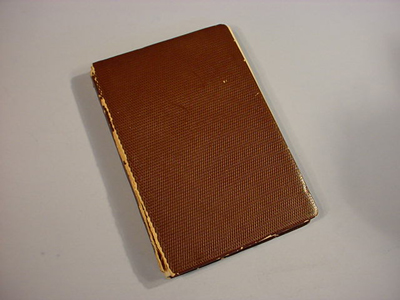 |
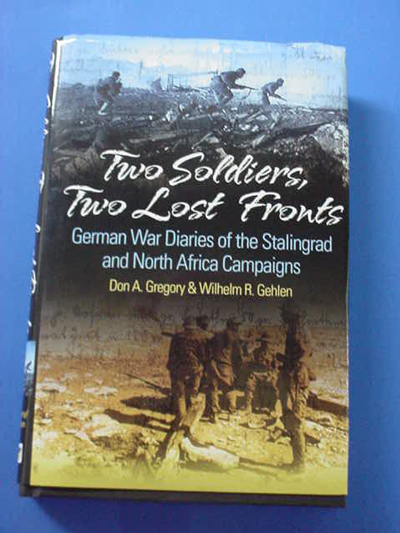 |
Album, Diary and a Published Book Concerning A Soldier of the Africa Corps FABULOUS! (Item WEHR 31-15 & AFRICA 1-13) |
DESCRIPTION: Yes, fabulous and yet that may be an understatement. The diary and photo album were the property of Rolf Krengel Afrika Korps and the photo album is also from him. It is the saga of a brave and true soldier of the Reich. The diary is the actual original handwritten copy. It starts with the beginning of the war and ends shortly after the Occupation. Serving primarily in North Africa, Krengel recounts with keen insight and now and then flashes of humor the day-to-day challenges of the Africa Corps in the desert battle and the lines are seldom clearly drawn. The narrative reveals an ad hoc campaign in which the average soldier never knew who had the upper hand. During one of the swirling battles in the desert, Krengel found himself sharing a tent with Field Marshal Rommel himself at a forward outpost. However, after the Battle of El Alamein, the cards of fate seemed clear. Evacuated back to Germany prior to the unfortunate collapse in Africa, Krengel continued to keep his journal during the last two years of the war, providing further insight into the final throes of the N.S. regime. He went on to become a successful economist and assisted the Allies with the Post-war Berlin airlift. Here is a first hand account found in the pages of this diary. Here are overviews, illustrations, and timelines with -- get this! -- a book published in 2009 written by Professor Don Gregory of the University of Alabama and Wilhelm Reinhard Gehlen who was born in Germany and was in the “Deutsches Jungvolk” the equivalent of the American Cub Scouts in Hitler’s Germany. After WWII ‘Willi’ joined the French Foreign Legion and served in Indo-China and North Africa. These two authors previously collaborated on Mr. Gehlen's acclaimed memoir, “Jungvolk the Story of a Boy Defending Hitler’s Third Reich.” Now, here is the fabulous part. Not only do we have the actual Krengel Diary and photo album but what goes with it is the actual book that was published that gives the entire translation for the diary day by day, while Krengel was with the 3rd Reconnaissance Battalion. Then the 5th Light Division/21st Panzer Division German Africa Corps/Panzer Army Africa. A great and typical narrative of the Infantry soldier who fought bravely for Fuhrer and Fatherland. The book by Gregory and Gehlen is called Two Soldiers, Two Lost Fronts, subtitled German war diaries of the Stalingrad and North Africa campaigns. Actually, it describes the service of both Rolf Krengel and another German soldier whose diary R. Gehlen decided to keep at this point. This other soldier must at this point be considered the “unknown” warrior as he as author of the diary did not see fit to include his name but if you read the account of his war experiences on the Eastern Front it is just as exciting as Krengel’s accounts. That soldier was a member of the 2nd Batt. 201st Panzer Regiment 23rd Panzer Corps Army Group A. We think this diary and album of R. Krengel is practically unique in that here you not only have the original documentation, but a book in English that is written by a learned professor and a battle experienced veteran of the Wehrmacht telling it as it was directly from the account of this A.K. soldier. We know of no other instance that something as personal and historically important as this group is being offered. The diary measures 8 x 5 inches and ½ inch thick. It contains page after page of hand written accounts by Krengel and even several drawings that he actually sketched. One in particular is my favorite showing an artistic conception of the face of the British enemy as Krengel envisioned it. A familiar face to Scottish, Irish, American Revolutionists and others who faced the cruelty of the British Grenadiers. I believe it was the Iron Duke (Wellington) who said of his soldiers at Waterloo “I don’t know if they frighten the enemy, but they scare the Hell out of me.” There are several photographs pasted on the pages as well. The photo album measures about 12 x 9 and has about 134 photos in it. Most of the photos are of Africa Corp Personal, aircraft officers, stage presentations at Command HQ, Artillery, Sport, and some neat photos of Krengel himself. Many of the actual pictures in the album are copied into the book and explained therein. The book by Gregory and Gehlen is 262 pages long with many pictures of German and Italian Axis soldiers and officials. All the dates and summaries in the book match the dates of the entries in the diary. What a combination! -- diary, album, and new book that traces it all for the reader. Please understand just how unique this truly is! The authors are to be highly commended for putting all of this together and the collector or archivist who decides to purchase this marvelous assemblage will be fortunate indeed. When it comes to provenance on articles of military history we are often asked what the provonance is. And our usual answer is that the inanimate objects cannot speak for themselves unfortunately. But here is the exception surely because this diary and album does in fact speak clearly and distinctly through the explanations and revelations of these two gifted writers in the present and the A.K. soldier Krengel speaks clearly and lucidly from the past. PRICE: SOLD |
 |
 |
An Original Period Model of a German Troop Car (Iem WEHR 31-16) |
DESCRIPTION: Leithtengelende Einheits Personen-Kraftwagen this was a light uniform all road car and was manufactured from 1940 by the Svgwer Company and also by BMW and Hano-Mag. The cars were all wheel drive and were produced with different style bodies. The model we have was the 4-man style with driver, gunner, officer and co-driver personell. The real autos were often used by the German Signal Corps as a radio car and also for forward reconnaissance. This is a period toy made in the 40’s. It is about 8 inches long with all metal wheels. To find one with all the soldiers there is seldom accomplished .Good condition overall. The soldiers are probably produced by Elastolin. Very rare and historically important as well. PRICE: $750.00 |
|
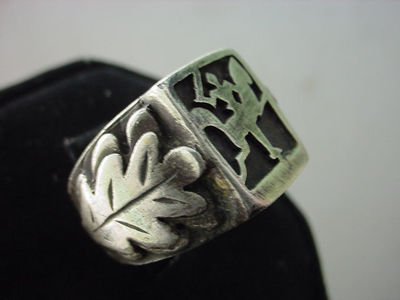 |
An Odd WWII Wehrmacht Unit Ring (Item WEHR 31-17) |
DESCRIPTION: This a Wehrmacht (Das Heers) ring. It is the unit ring of the Deutsche 24th Panzer Division. We have a narrative on our home page entitled “About Our Rings and Silver Insignia,”perhaps you have read it but if you have not, then I really suggest that you do so and then you will have an understanding of how all of these fabulous pieces of jewelry were obtained by us in Stuttgart, Germany. This would have been a private contract with the divisional commandant of the 24th Panzer Division, who then would have presented them to the men of his command. PRICE: $265.00 |
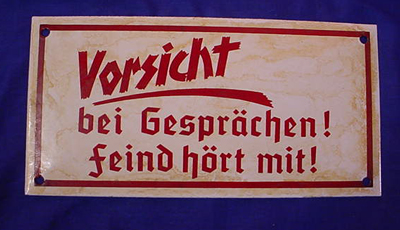 |
Vorsicht! A Metal Sign of Warning (Item WEHR 31-18 & GEN 14-16) |
DESCRIPTION: This is a warning to service personal and German citizens during WWII that they should be alerted to the danger of loose talk on telephones and other means of communication. The words Vorsicht Bei Gesprachen, Feind Hort Mit! This means: Caution with your conversation! The enemy is listening! With such Freedom eroding laws & unconstitutional measures imposed on Americans today with the ‘Patriot Act’ and ‘Homeland Security’ this sign has real meaning in 21st century America as well. The sign is in heavy gage steel enameled over. It has four holes, one at each corner so it may be secured in place where it would be a reminder that loose lips are the friends of the enemy. The sign measures 8" x 4" and is in good shape with a little staining that will wash off. We leave them as we get them! PRICE: SOLD |
 |
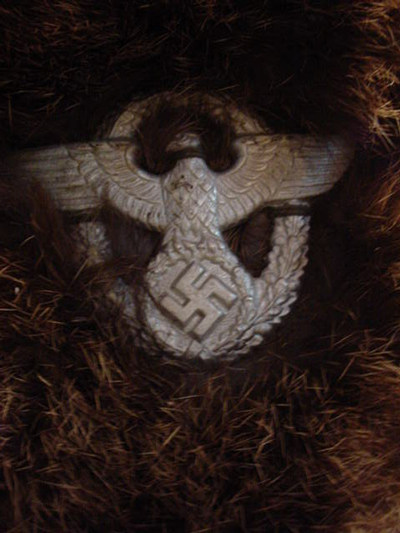 |
WWII German Army Rabbit Fur Cold Weather Hat (Item WEHR 31-19) |
DESCRIPTION: This rabbit fur cap is the typical cold weather issue that was used by various Wehrmacht units. This one by the military police who often had to stand for hours directing military traffic and also performing the duties of the “Field Cop” and this necessitated the warmest of clothing especially in Russia each unit of the German Wehrmacht was issued these caps with the cloth parts closely matching the uniform of the particular recipient. This one was for the MP’s and it has the police eagle device sewn to the front face. Army and Luftwaffe personnel had the particular insignia of their branch affixed in the same way on the ones issued to them. The cap in is 100% perfect condition. It is marked inside with the numbers and letter R.B.Nr 0/1200 and under this 58-41. This is the size and date of issue. The fur is soft and completely intact. A very nice speciman of excellent German workmanship technique. This cap might be practical as well as a collectable considering the strange weather patterns as of late! PRICE: SOLD |
 |
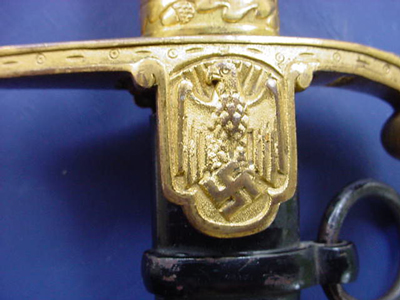 |
Von Stein WW II German Army Sword (Item WEHR 31-20) |
DESCRIPTION: This Von Stein pattern sword is an aluminum example, exhibiting rich gilding throughout its surfaces. In fact, the gilding work on this sword is nearly 100%. The Von Stein sword is one of the famed field marshal series and can be seen in the Angolia Book on page 79. It is named for the famed German marshal of the Napoleonic wars, Freiherr von Stein. This example has a dove head style pommel with a flowing backstrap and side tabs which all portray raised-out oak leaves with acorns. The “P” guard also has an oak leaf acorn sprig design. The same is true of the ferrule. The cross guard area has a series of dot and dash markings and at the langet there is a Wehrmacht eagle. This bird is shown in relief and he has half-closed wings, looks to the viewer’s left and clutches a swastika.. The grip is the standard wood base having celluloid covering. The celluloid is in perfect condition having fine factory sheen. This grip is tightly wrapped with triple aluminum wire, the center being twisted. The lower portion of the sword guard is stamped, “Ges. Gesch.”, indicating that the Eickhorn firm had a patent pending on the design. The scabbard is nice and straight. The scabbard is without any bending or dented, but it has been very professionally re-painted in the exact hue that the original scabbard was finished in back in those early days in Solingen. The very fine blade is 33 inches in length. It has been quality nickel-plated and has a bright mirror finish. This blade is in near mint condition. The reverse ricasso is stamped with the 1935-41 seated squirrel logo. The original tan leather washer is in position. A fine looking and semi rare Von Stein example offered here. PRICE: SOLD |
 |
Carved Bread Plate from the Military Postal Police (Postshutz) in Krosno, Poland (Item WEHR 31-21 & BRE 1-6) |
DESCRIPTION: This may be the finest German bread plate we have ever seen and we have seen many fine collections of them. This plate is expertly carved with the eagle of the German Military Postshutz eagle as its central design. The Postshutz (Postal Police) comprised about 4,500 members stationed all over Europe and they were tasked with the security of Germany’s Reichspost; they were not only responsible for security of the mail but other communications media such as telephone and telegraph systems. The plate was from the HQ of this organization in Poland. They were stationed there after the Polish attack on the German radio station at Gleiwitz, in 1939 -- the event that after many Polish atrocities against the German minority in Poland finally launched the German retaliation and began WWII. After that vicious attack units of the postal protection police were dispatched to several locations in Poland to prevent something like this happening again. One of these outposts was Krosno which is a medieval fortified town; a former royal “free town” in medieval Europe. The carved plate was probably a gift from Poles who not only cooperated with the German occupiers but actually sided with their mission of destroying Soviet Communism. There were many who thought this way. The contemporary orthodox history books do not mention this of course. The dish says along its edges "Deutsche Post Osten 1939-1942 Krosno." It measures 11 inches in diameter and is in excellent condition. The carved Postshutz eagle rises in deep relief carving and is very dramatic. It is the eagle that you see in the middle of the grip of the rare Postshutz daggers. The piece is not only artistically great but is a really important historic relic of the turbulent time! PRICE: SOLD |
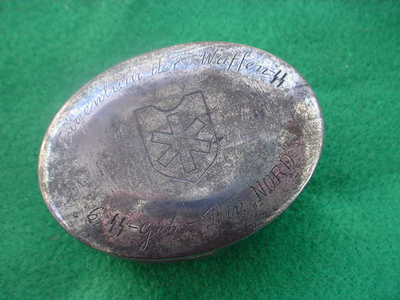 |
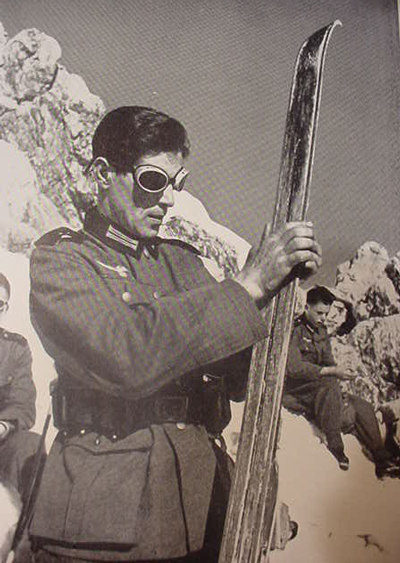 |
Cased Set of Snow Goggles for SS Mt. Troops (SS Geburgsjager) (Item WEHR 31-22) |
DESCRIPTION: Here is something seldom found. It is a cased set of goggles used in winter combat by the SS Mountain Troopers of the SS Geburgsjager Division “Nord’ and this wording is engraved on the outside of the case. It also says Eigentum Der Waffen SS; this sentence means Property of the Waffen SS. In the middle is the runic symbol for this elite corps. The box measures 3x2 across the box top and 1 ½ inches deep. The goggles are with blackened lenses and black fabric head band. The Kampfgruppe Nord was formed from the 6th and 7th SS Totenkopf Standarten in 1941. In 1942 they became the SS Division Nord and in May of 1942 they became the SS Gebirgs Division Nord. They fought bravely as the SS DivisionNord against the Russians on the Kald Peninsula and in subsequent hard fought conflicts. They saw combat in the Finnish Front along with the brave Finns until the Finish Government made a Devil's pact with the Soviets and then ordered all German Army and SS units to leave Finnish territory and in September 1944 the 6th SS Division Nord began its retreat across Finland to the West. Later they participated in the Ardennes Offensive. After continuous fighting in this area, the Division retreated to the North where it was engaged once more with the advancing English and American enemy. In the vicinity of Worms, eventually after heroic action, they surrendered to the Americans. Usere Ehre Heist Treue! This was their clarion call and their sacred pledge right to the end. PRICE: SOLD |
 |
Der Kampf in Westen 3-D Book “Raumbilderbuch ” (Item WEHR 31-23) |
DESCRIPTION: OK, collectors, here is one of the fabulous 3-D books that were produced by the firm of Heinrich Hoffman in Munich. The subtitle is “Die Soldaten Des Führers Im Felde" (The Soldiers of the Fuhrer in the Field). It was published early in the war in 1940. These Raumbilder books were all the rage back then and are very popular today when found. We have had several of them including some of the rare titles. The one most profusely produced in the Third Reich was this one because it celebrated the dazzling victory of the German Army in the West right up to the fall of France to the German Wehrmacht. The German people rejoiced in this and the purchase of these books that told the story in 3-D was more popular than “Leberwurst”! Who can blame them? These actions were the first steps in a war lamented by Hitler but necessary to stem the tide of British encroachment and the soon to come onslaught of the Russian Communists. The people were overjoyed at the success of their fighting soldiers. And the book shows the prowess, dash and daring of these soldaten at the front. Great scenes of the forward advances and early victories. Pictures of scroungy looking White and Negroid French prisoners, sharp German officers of the army, air force, etc. right up to the surrender of the French armed forces at Compiegne in the same railroad car that the Germans had to surrender to the French in 1918. This was the most glorious moment for the Führer, his army and the German people. But from 1943 it was all down-hill because the misguided Allies pushed on to utterly defeat Germany with its superior fire power and endless supplies that Germany did not have, thus the bulwark against the Eastern hordes of Bolshevism was destroyed and the West has been in danger ever since of losing also due to the influence of its traditional enemy and its most diabolical offshoot, communism. Enough of my history lesson. The book itself is a history lesson portrayed before you in three dimension just like you are standing there personally (Do I hear the music of twilight zone!) The stark realism cannot be compared to looking at pictures in a regular book as fine as they might be. Before Japan got into the art of special photography, Germany excelled in state of the art photographic innovation. Now that 3-D is so popular out of Hollywood, it really has nothing on this 1940’s Raumbilder process. We have another copy of this prodigiously book on our site at WEHR 10-5 on the Wehrmacht section. This one that we offer here is not nearly in as good condition as the one I just mentioned. The cover is quite tattered with the spine taped some time ago and it has rips at the edges and also tattering. The spine was glued to hold at some time or another. But the pages are all there with the brilliant color plates. It has all 80 pages, the viewer is in good shape and the cards are also. There should have been 100 cards but a dozen are missing. However, these books are so very rare today that this one will be considered extremely reasonable compared with what they bring in Germany today. It is still a great historical treasure if only for the pictures, so we offer it for the bargain price of... PRICE: $198.00 A real bargain, better grab it! |
 |
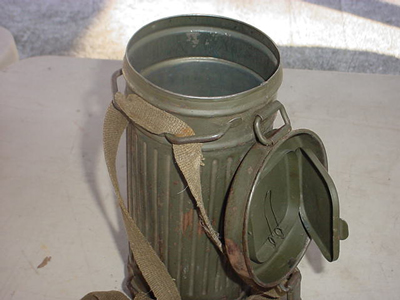 |
German WWII Gas Mask Container (Item WEHR 31-24) |
DESCRIPTION: Here is a container for the gas mask issued in WW II to the German Army and Waffen SS personal. Poison gas was not used in WWII although the British and Americans longed to use it. It was the most horrible weapon other than the Allies atom bomb ever devised to be sent against soldiers in the field. It was used so frequently in WWI that it gave rise to the term “The Chemist's War.” One notable poison gas victim of WW I was Adolf Hitler who was temporarily blinded while healing in a hospital in Wervik; as a result Hitler adamantly refused to authorize the use of poison gas on the battlefield in World War II. However, the High Command of the Wehrmacht did not trust the Allies with good reason and retrospect. So, German soldiers were issued gas masks in the event that the Allies would suddenly introduce this cruel and horrible type warfare. The only reason they didn’t was fear of retaliation in kind. Their genocidal bombing raids on Hamburg Koln, and especially Dresden, proved that their only regard for human life was to run up their score of kills on human targets and mostly civilian. So the soldiers of the Fatherland carried their gas masks right up to the end. But why do we find so many of the canisters empty of the gas mask. Because from 1940 on the soldiers were fairly sure that they would never encounter gas at the front. Their code of honor however was theirs alone in WWII and although it was extremely ‘chancy’ thousands of them threw away the mask and kept the canister as a handy ‘catch all’ for trinkets, goodies and yes, collectables! This one we offer has all the original straps and is in good condition throughout. PRICE: $175.00 |
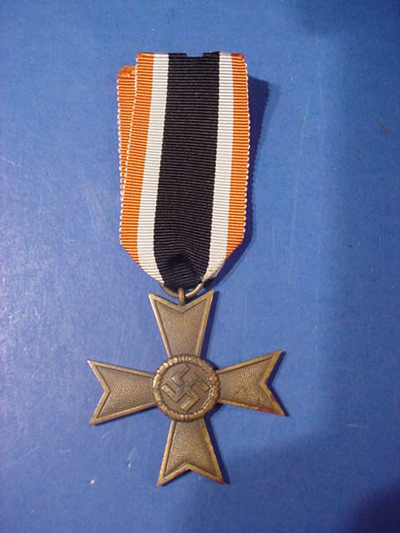 |
 |
War Service Cross with Issue Envelope (Kriegs Verdienstkreuz) (Item WEHR 31-26) |
|
DESCRIPTION: This is the 2nd Class without swords (mint condition) with ribbon. Adolf Hitler directed that a decoration should be struck that would recognize service in the war effort that would fall short of the award of the Iron Cross. This medal was instituted on 18 Oct 1939 and even civilians could win this coveted award who performed outstanding service. The war merit cross was instituted with and without swords in a 1st and 2nd class. The class without swords was a non-combatant award but could be given for duties performed for the Fatherland exceeding the feats that would be given to military recipients who received the cross with swords. To find one with the issue envelope is rare. PRICE: $150.00 |
|
 |
War Service Cross Without Swords (Kriegsverdienst Kreuz) (Item WEHR 31-27) |
DESCRIPTION: Another like the one listed above but without issue envelope (condition mint!) but with some stain on the back portion of the medal. PRICE: $80.00 |
 |
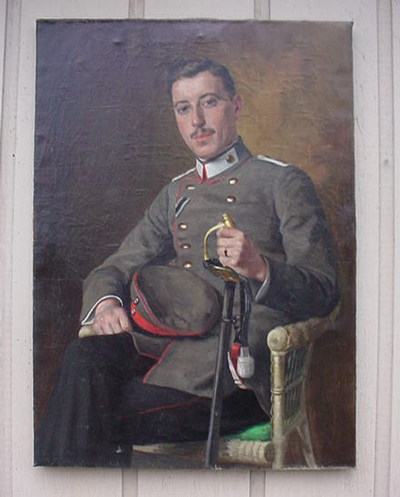 |
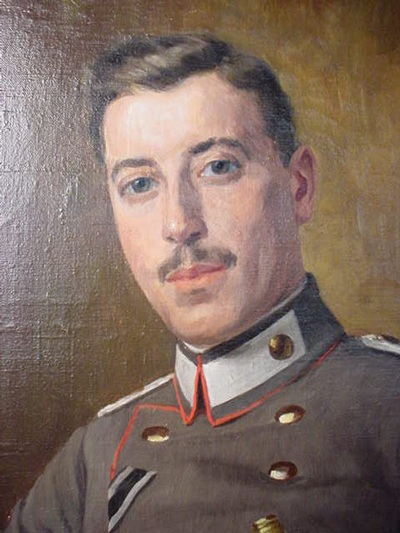 |
Utterly Magnificent WWI & WWII Group Belonging to One Officer of the Deutsches Vaterland (Item WEHR 31-28 & WWI 12-8) |
DESCRIPTION: This has to rate as one of the absolute best groups we have ever offered at Germania International. In a word, incredible. The articles were the personal possessions of Herr Konrad Lepper who served in WWI and won the Iron Cross First and Second Class and was an adjutant, so we are told, in the unit I/417 and worked up the ranks to being an Oberstleutnant in 1942. The Second World War, he was in the Gebirgsjager Corps (Mountain Infantry) or at least that is indicated by the color of the underlay on his shoulder boards...light green Waffenfarbe. With the group there is a cigarette case that is crafted in 800 silver. It measures 3 ½" x 3" and about ½ inch thick; it has the Hohenzollern eagle in its center and K.L for Konrad Lepper. The initials are on the left (K) and in the bottom right (L) on the inside of the case. It is presented to Lepper with the words that are hand engraved -- Ihrem Lieben Adjutanten Lepper 2-M 14 5 1917. “To the Dear Adjutant Lepper’. Then there are what looks to be five facsimile signatures of officers that were presenting the case to Lepper. The only one at his point that we can make out clearly is Kluge -- this could be the famed General Von Kluge of WWI and WWII fame. That might have been the officer that Leper was adjutant to. With the group are 10 medals in parade dress mount and his shoulder boards from his WWII rank -Oberstleutant 1st Colonel in the 15th Mountain Troop Battalion. His medals are mounted on a board that is similar to the funeral pillow that is used in display, these would be the awards won in the career of a soldier then deceased and this might well be the case here. We received them mounted like this when we purchased the group. Note the medals in our pictures and they are from the top on down:
On the Next medal grouping parade bar we find:
On this board you can also see Lt. Col. Lepper's WW II shoulder boards from the 1st Gebirgsjager Regiment. We would hazard a guess that Lepper may have been retired at the age of 52 in 1943 or 53 in 1944. He was born May 14th, 1871. We say this because of the Weimar Kyfhauser bund medal and the N.S. Faithful Service award; it indicated he may have been in the Civil Service even before the First World War. To continue we come to the most incredible part of the group and that is a beautifully rendered oil portrait of the Soldat Lepper in full uniform in the WWI era with his sword. This is a large painting 42” x 30”. It is actually from the period 1914-1918 and it is in fine condition. We had to remove the frame to send the painting home but believe me the frame was nothing we would treasure. It was a black painted common frame in chipped up condition and this magnificent oil deserves a better framing job in any case. We leave that to the buyer. The painting is unsigned but is obviously the work of a truly professional artist; very life-like portrait of a real career officer, Germany’s finest. Also fantastic is that we have the actual Mod 1889 Infantry officers sword that you see in the picture with Lepper's initials K.L. engraved in the pommel section. The sword is in all around great condition The wire wrapping is tight, the brass is all still with 90% of its original gilted patina. The scabbard shows use but no abuse. The blade is plain steel. Unsigned, with double blood gutters. The royal Prussian crest are perfect as is the eagle on the brass foldable guard The sword in its scabbard is 36 inches long. Herr Lepper was a proud German soldier so it is not so unusual to find their initials or names on the swords. Usually it is the career men who are “button busting proud” of their army, their nation and their family who would have this done. To continue, we have Lepper's Wehrmacht officers model ‘Heersdolch’or (army dress dagger) with original portepee (knot) and hanger. The dagger was manufactured by the famous Solingen Firm of Puma. The cross guard on the back incredibly has his initials once again (K.L.) done in classic Germanic letters that exactly match the personalization on the sword. This dagger is in average to very good condition. The blade is bright but could have at one time broken at the tip. But if so it has been expertly repaired even if shortened by a ¼ inch or so. The grip may have had a chip near the cross guard but that also was excellently repaired. The scabbard shows some plating loss here and there but we think Lepper was no armchair officer; he was probably busy most of the time and wearing the weapon all the time as an adjutant. The supplied hangers show use but are still good and serviceable (and highly collectable); all in all a very nice specimen of the official dress dagger of the German Army. Next, and this is incredible, the original three promotions that Lepper earned through his long military career. This starts with:
Next: When an officer reaches the high rank of Oberstleutenant the official Wehrmacht inspection always came to pass. And this was similar to the Party Rasse und Siedlungshauptamt “Race and Resettlement Office.” They wanted to know if the officer was of pure Germanic descent according to paragraph (1.) The law of Aryan descent. This was under the Reichsgesetzblat-filing system 1063 it says “We hereby certify that Oberleutnant Konrad Lepper who was born 14/5/91 is of German descent as is his wife Martha who was born Hupfeld Nov 1st 1893 and as far back as her grandparents is also Aryan Approved by inspection of official records here in Oct 1935. This was signed in Kasssel the 22nd of December 1942. It has the stamp of the inspection office and is signed by a captain and adjutant. This file paper is 8 x 6 inches in size. Last but not least is an envelope minus the letter -- 5 ½" x 4" addressed to Oberstleutnant Lt. Lepper # 316-2 509 083 U.S. Army POW 1 B France and dated 29 May 1946. It says to the side (German) and at the top Prisoner of War post. On the back it says Lepper Bringhausen UB Wildungen 16 Germany. We believe this was a letter from his father or mother but could be from his brother or sister while he was a prisoner of war in France but at a US prisoner facility. So here we have one of the most complete groupings of the personal articles ever offered -- absolutely stupendous! How and why they were ever released and sold by the family is unknown to us. Perhaps it is because of the slander and debasement of Germany’s soldiers taught in the post-war German schools and in fact even in the media today in the Orwellian world we now seem to have reached. Or perhaps most of the Lepper family is gone leaving behind a few of the ‘new’ Germans who have adopted the “Coca-Cola and gum chewing culture”. These types would sell their history and heritage in a snap! It means nothing to them. If they would be asked if they knew the difference between ignorance and apathy their answer would likely be “I don’t know and I don’t care!” Think about that one. To us this collection is truly a Germanophiles dream and a tribute to a brave soldier of the Reich. May he rest in glory! Alles für Deutschland! PRICE: SOLD List of items with Group:
|
Page Thirty-one |
Please refer to item designator in parentheses in all correspondence.
Please E-mail for any additional information you may need.